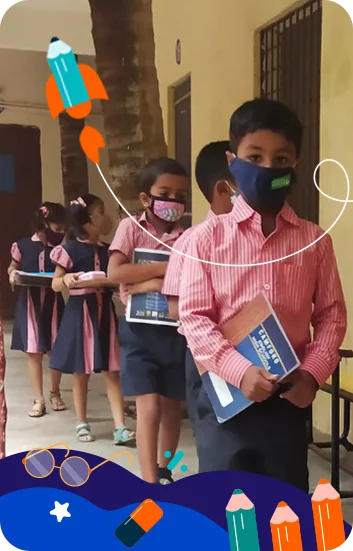How Indian schools can think beyond the textbooks?
.png)
Give Your School The Lead Advantage
When we talk about learning, the image that jumps to our minds is often that of the textbook. We, in India, may have begun to move away from the idea of rote learning from bulky textbooks but are we really tapping into the potential of technology in this sector? Are we able to move beyond the idea of technology being just a screen or a device into an approach that infuses every step in the learning process using integrated solutions? Can we bring together all the stakeholders—students, teachers, parents and administrators—to interact and collaborate in a seamless manner with the aid of technology?
These are indeed weighty questions and the answer is perhaps to go to the basics, to lay emphasis on the fundamentals of learning itself while producing material for students and teachers. At LEAD-powered schools, the first step has been to see education as a factor of learning outcomes (LOs), and then packaging these outcomes into measurable Indicators of Learning. In place of rote learning, students first master skills and then demonstrate this mastery, thus concretising what is learned and setting the foundation for the next stage. This philosophy underlies the content we create for teachers and students based on the idea of progression – that no concept exists in isolation as it is organically linked to what has already been learnt and what will be learnt.
How does this integrated approach work in concrete terms? Let’s take the design of a textbook, for instance. The process begins with the creation of a progression that maps the concepts in the context of what has been learnt before and what is to be learnt in the future. This is followed by a detailed blueprint that lays out the LOs–along with possible formats these can be explored through—and, finally, the detailed breakdown into chapters. While the whole process takes about six months, it is by no means the end; there is a constant process of evolution and incorporation of feedback to tweak the content.
The LEAD School team also focuses on customisation by decoupling the tools teachers and students use in the classroom. Thus, the teacher has both a textbook and a tablet while the student has a supplementary reader, as well as a student app. Our experience has been that this decoupling transforms the very nature of the classroom. On the one hand, the teacher is provided with a detailed day-to-day plan with supplementary tools to assist in the teaching while students get enough flexibility to learn at their own pace with none falling behind. When the teacher completes covering the stipulated concepts and updates that on their tab, quizzes are available for students to solidify their learning. The data produced from these steps is carefully parsed to provide teachers and administrators the information on when and how to intervene.
The flexibility of the system was exemplified by the COVID-19 pandemic where LEAD School@Home enabled us to provide direct content to the students in the early stages itself, with teachers coming on to the platform and using our digital content to provide a quality of instruction far superior to the otherwise prevalent, but rudimentary, Zoom lessons. LEAD School@Home classes also provided parents an opportunity to participate in the process, giving them a vital say in their children’s education.
The best part of a solution like LEAD School@Home is that there is so much potential ahead. The student app, for instance, offers a great possibility in ensuring remedial programs for students. Currently, we provide an analysis of strengths and weaknesses in terms of LOs to teachers who are then well-equipped to address them through remedial interventions. This vital effort by teachers is also supported by remedial content and analysis on the student app as well.
Breaking the grade boundaries
LEAD School’s approach and philosophy are perhaps best encapsulated in its ELGA (English Language and General Awareness) programme, which brings together all of the above features with multi-age, level-based classrooms, enabling schools to break the structural constraints of grades and chapters. Students in ELGA classrooms have displayed a much more rapid rate of learning as they are able to progress at their own pace and master the fundamentals of English, which act as a base for learning all other subjects as well.
The future of education clearly lies in content as an experience; content that is customised for each stakeholder, that can be adapted to different levels of absorption by students and is connected to prior learning and everyday life itself. Gone are the days of textbooks that remained unchanging, had to be memorised, and had little to do with practical life. The time of agile, flexible, and futuristic education solutions has arrived, and LEAD School looks forward to the welcome changes this will bring.
Want to give your child excellent education and make them ready for the future? Enrol them in a LEAD powered school: Fill the admission form now

